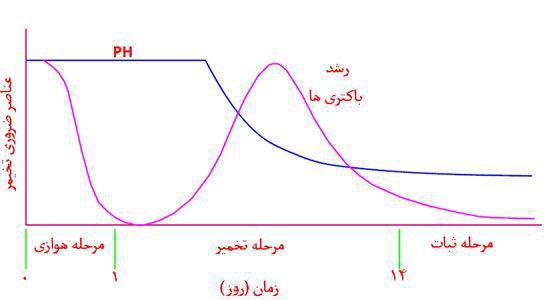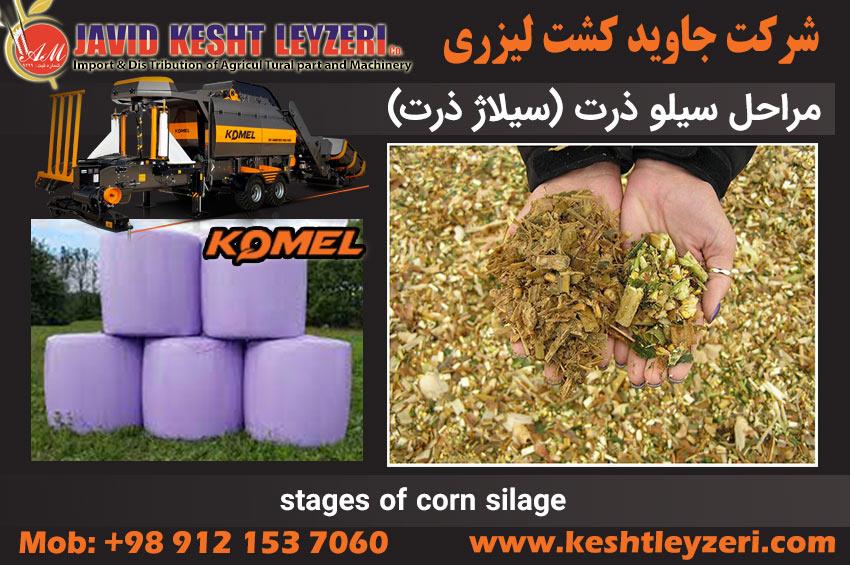شیوههای مدیریتی مختلفی که برای سیلو کردن گیاه ذرت مورد استفاده قرار میگیرد میتواند بر کیفیت و کمیت مواد مغذی آن اثر داشته باشد.
برای دریافت اطلاعات در مورد دستگاه بسته بندی علوفه و دستگاه سیلاژ علوفه، قیمت خرید دستگاه بسته بندی علوفه و مشاوره خرید کافی است با مدیر فروش شرکت جناب آقای مهندس مردانی با شماره همراه 09121537060 تماس بگیرید و یا از طریق پیام رسان ایتا و واتساپ به ایشان پیام ارسال نمایید.
یست مطالب این بخش:
در ادامه مطالب فوق توضیح داده می شوند.
سیلوی ذرت، بخش اول- مرحله برداشت
سیلوی ذرت معمولا دارای دو معنی می باشد: اولی به معنای ساختمان یا محلی است که گیاه خرد شده ذرت در آن انبار و نگهداری می شود و دومی ، فرآورده نهایی تخمیر گیاه ذرت خرد شده در یک محیط بی هوازی است . در این متن، در حالت دوم از اصطلاح سیلاژ استفاده می شود. شیوه های مدیریتی مختلفی که برای سیلو کردن گیاه ذرت مورد استفاده قرار میگیرد می تواند بر کیفیت و کمیت مواد مغذی آن اثر داشته باشد. علاوه بر نحوه زراعت، انتخاب مرحله مناسب بلوغ برای برداشت محصول و نوع هیبرید از مهمترین فاکتورهایی مدیریتی هستند که ارزش غذایی سیلاژ را تحت تاُثیر قرار می دهند. به عبارت دیگر تولید سیلاژ ذرتی با ماده خشک بالا و تولید شیر بیشتر از گاوهای مصرف کننده آن، بستگی به برداشت آن در مرحله مناسب بلوغ و نوع هیبرید دارد .
برای دریافت اطلاعات در مورد دستگاه بسته بندی علوفه و دستگاه سیلاژ علوفه، قیمت خرید دستگاه بسته بندی علوفه و مشاوره خرید کافی است با مدیر فروش شرکت جناب آقای مهندس مردانی با شماره همراه 09121537060 تماس بگیرید و یا از طریق پیام رسان ایتا و واتساپ به ایشان پیام ارسال نمایید.
کلمات کلیدی: قیمت دستگاه سیلاژ علوفه,قیمت دستگاه بسته بندی علوفه,فروش دستگاه سیلاژ علوفه,فروش دستگاه بسته بندی علوفه,خرید دستگاه سیلاژ علوفه,خرید دستگاه بسته بندی علوفه,دستگاه بسته بندی علوفه,دستگاه سیلاژ علوفه,دستگاه سیلاژ ذرت علوفه ای,دستگاه سیلاژ تفاله مالت,دستگاه سیلاژ ذرت,دستگاه بسته بندی ذرت علوفه ای,قیمت دستگاه سیلاژ ذرت علوفه ای,قیمت دستگاه سیلاژ,فروش دستگاه سیلاژ,دستگاه سیلاژ تفاله چغندرقند,دستگاه بسته بندی تفاله چغندرقند ,دستگاه سیلاژ یونجه,قیمت دستگاه سیلاژ یونجه,فروش دستگاه سیلاژ یونجه,قیمت دستگاه سیلاژ مالت علوفه ای,خرید دستگاه سیلاژ یونجه
مطالعه های مختلف نشان داده است با افزایش سن گیاه میزان ماده خشک گیاه ذرت بیشتر می شود که این موضوع به دلیل افزایش میزان دانه در گیاه ذرت میباشد. از سوی دیگر، مقدار ماده خشک گیاه را می توان توسط مرحله یا میزان رسیدگی دانه تخمین زد. همچنین، رسیدن دانه به وسیله موقعیت خط شیری در آن تخمین زده می شود. خط شیری، خط سفید رنگی است که بخش نشاسته جامد را از بخش شیری دانه جدا می کند. این خط در اوایل مرحله خمیری آشکار شده و با افزایش سن بلوغ، به سمت پائین دانه حرکت می کند . به عنوان مثال، اگر خط شیری در وسط دانه قرار گرفته باشد سن گیاه را مرحله یک دوم خط شیری ( Milk line½) ذکر میکنند. از طرف دیگر، زمانی که گیاه ذرت به بلوغ کامل می رسد خط دیگری به نام خط سیاه در انتهای دانه ها ظاهر می شود.
تحقیقات مختلف نشان داده است که با افزایش سن گیاه از مرحله شیری شدن دانه تا مرحله دو سوم خط شیری، مقدار نشاسته و انرژی افزایش و درصد دیواره سلولی ، دیواره سلولی بدون همی سلولز ( ADF) و پروتئین خام گیاه کاهش می یابد اما از مرحله فوق تا مرحله خط سیاه، درصد این مواد غذایی بسته به نوع هیبرید، نحوه زراعت و فاکتورهای دیگر، ثابت باقی مانده یا کاهش می یابد.

بررسی اثر سیلوهای ذرت با رطوبت های متفاوت بر مصرف ماده خشک و تولید شیر در گاوهای شیری نشان داده است سیلوهایی که از ماده خشک بیشتری برخوردار بودند سبب افزایش مصرف ماده خشک جیره و تولید شیر بشتر گردیدند که دلیل آن مر بوط به افزایش میزان نشاسته و کاهش درصد دیواره سلولی در سیلوهایی بود که از درصد ماده خشک بشتری برخوردار بودند.
با عنایت به مطالب گفته شده، بهترین زمان برداشت ذرت بین نیم تا دوسوم خط شیری می باشد که براساس ماده خشک گیاه در این مرحله های بیشتر از 30 درصد است.
سیلوی ذرت،بخش دوم- فرآینده ذخیره کردن
در بخش اول سیلوی ذرت، مطالبی در خصوص اهمیت زمان برداشت ذرت ارائه شد. در این بخش، فرآیندهایی که در یک سیلو صورت می گیرد توضیح داده خواهد شد.
فرآیند سیلو کردن به طور کلی به 4 مرحله تقسیم میشود که عبارت است از:
الف- مرحله هوازي Aerobic Phase
این دوره با برداشت محصول وپر کردن سیلو آغاز می شود و بسته به میزان هوای موجود در آن از چند ساعت تا چندین روز ادامه می یابد. در این مرحله دو دسته عوامل تخریب فعالیت میکنند که اولی آنزیم های گیاهی و دومی میکروب های هوازی نظیر مخمرها و کپک ها می باشد که ماحصل فعالیت آن ها تولید گاز (عمدتا گرما) و درنتیجه از بین رفتن مواد غذایی سیلو میباشد. سرعت پر کردن و میزان کوبیدن سیلو از عواملی هستند که مقدار هوای موجود را تعیین میکند. به بیان دیگر اگر سیلو دیر پر شود یا سیلو به خوبی کوبیده نشود هوای بیشتری در بین ذرات آن باقیمانده و باعث فعالیت بیشتر این دو دسته عوامل تخریب میشود.
ب- مرحله تخمیر( Fermentation Phase) :
این دوره با اتمام اکسیژن در سیلو آغاز میشود. در این دوره، دو دسته میکروب فعال میشوند که اولی میکروبهای مفید بوده که همان باکتریهای اسید لاکتیک میباشند که با مصرف کربوهیدراتهای محلول در آب سبب تولید اسید لاکتیک شده که به دلیل قویتر بودن این اسید نسبت به سایر اسیدهای آلی موجود در سیلو، آن را مسؤول کاهش pH سیلو میدانند. از طرف دیگر کاهش pH تا نقطهای ادامه دارد که بیشتر میکروبها و فعالیتهای زیستی متوقف شود.
میکروبهای غیر مفید نظیر انترباکتری ها و کلستریدی ها دسته دیگری هستند در این مرحله فعالیت میکنند. وجود pH و رطوبت بالا (بیشتر از 75 درصد) از شرایط مناسب برای رشد و فعالیت این گروه میباشد. این میکروب ها، علاوه بر اینکه در مصرف قندهای قابل استفاده در سیلو، با باکتری های اسیدلاکتیک رقابت میکنند بلکه از طرف دیگر، با تجزیه پروتیین ها، سبب کاهش ارزش غذایی سیلاژ و تولید اسید بوتیریک و ترکیبات سمی نظیر آمین های بیوژنیک میشوند که اثر منفی بر خوش خوراکی محصول سیلو شده و سلامتی دام خواهد گذاشت.
در برخی منابع، مرحله ابتدایی مرحله تخمیر رو تفکیک کرده و آن را فاز تاخیر ( Lag Phase) تعیین کرده اند. در این مرحله، غشای سلولی گیاه توسط میکروارگانیسم ها تخریب شده و در مایع سلولی شروع به رشد می کنند. مدت این مرحله یک روز می باشد.
ج-مرحله ثبات (Stable Phase) :
این دوره با کاهش pH به نقطه ای که بیشتر میکروبها غیر فعال شوند آغاز و تا زمانی که هوا وارد سیلو نشود این مرحله ادامه دارد.

فرآیندهایی که داخل سیلو تا زمان استفاده از آن اتفاق می افتد
د- مرحله برداشت (Remove Phase) :
به محض این که سیلاژ در معرض هوا قرار گیرد این دوره آغاز میشود. در طول برداشت سیلاژ برای تغذیه دام، این امر اجتناب ناپذیر می باشد، اما فساد هوازی که توسط میکروب هایی نظیر مخمرها و کپک ها انجام می گیرد می تواند زودتر هم شروع شود که دلیل آن مربوط به آسیب پوشش سیلو می باشد.
برای دریافت اطلاعات در مورد دستگاه بسته بندی علوفه و دستگاه سیلاژ علوفه، قیمت خرید دستگاه بسته بندی علوفه و مشاوره خرید کافی است با مدیر فروش شرکت جناب آقای مهندس مردانی با شماره همراه 09121537060 تماس بگیرید و یا از طریق پیام رسان ایتا و واتساپ به ایشان پیام ارسال نمایید.
کلمات کلیدی: قیمت دستگاه سیلاژ علوفه,قیمت دستگاه بسته بندی علوفه,فروش دستگاه سیلاژ علوفه,فروش دستگاه بسته بندی علوفه,خرید دستگاه سیلاژ علوفه,خرید دستگاه بسته بندی علوفه,دستگاه بسته بندی علوفه,دستگاه سیلاژ علوفه,دستگاه سیلاژ ذرت علوفه ای,دستگاه سیلاژ تفاله مالت,دستگاه سیلاژ ذرت,دستگاه بسته بندی ذرت علوفه ای,قیمت دستگاه سیلاژ ذرت علوفه ای,قیمت دستگاه سیلاژ,فروش دستگاه سیلاژ,دستگاه سیلاژ تفاله چغندرقند,دستگاه بسته بندی تفاله چغندرقند ,دستگاه سیلاژ یونجه,قیمت دستگاه سیلاژ یونجه,فروش دستگاه سیلاژ یونجه,قیمت دستگاه سیلاژ مالت علوفه ای,خرید دستگاه سیلاژ یونجه







